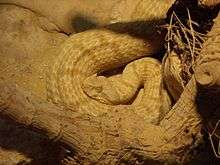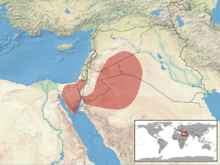Pseudocerastes persicus fieldi
| Pseudocerastes persicus fieldi | |
|---|---|
 | |
| Scientific classification | |
| Kingdom: | Animalia |
| Phylum: | Chordata |
| Subphylum: | Vertebrata |
| Class: | Reptilia |
| Order: | Squamata |
| Suborder: | Serpentes |
| Family: | Viperidae |
| Subfamily: | Viperinae |
| Genus: | Pseudocerastes |
| Species: | P. persicus |
| Subspecies: | P. p. fieldi |
| Trinomial name | |
| Pseudocerastes persicus fieldi K.P. Schmidt, 1930 | |
 | |
| Synonyms | |
- Common names: Field's horned viper.[3]
Pseudocerastes persicus fieldi is a venomous viper subspecies[4] endemic to the deserts of the Middle East. The main differences between this subspecies and the nominate race are in scalation and venom composition.
Etymology
The subspecific name, fieldi, is in honor of American anthropologist Henry Field, who collected the holotype. The Field Museum of Natural History in Chicago and its scientific publication, Fieldiana, in which K.P. Schmidt's original description of this viper appeared, are named for Henry Field's grandfather, Marshall Field.[5]
Description
Outwardly, P. p. fieldi differs from P. p. persicus in certain (lower) scale counts:[6]
| P. p. fieldi | P. p. persicus | |
|---|---|---|
| Scales separating nasal and rostral | 1 | 2 |
| Dorsal scale rows at midbody | 21-23 | 23-25 |
| Ventral scales | 127-142 | 144-158 |
| Subcaudal scales | 34-46 | 38-48 |
Additional differences from P. p. persicus include much shorter (relatively to the overall body length) tail as well as the fact that while in P. p. persicus all dorsal and lateral scales are strongly keeled, P. p. fieldi has several rows of almost smooth lateral scales.[7]
Geographic distribution
According to McDiarmid et al. (1999) P. p. fieldi is found in the Sinai Peninsula, Israel, Jordan, northern Saudi Arabia, northwestern Iraq, and possibly in southern Syria.
The type locality given in the original description is "Bair Wells, Transjordania" [Jordan].[2]
According to Mallow et al. (2003) it is found in the Sinai Peninsula, southern Israel, Jordan, extreme northern Saudi Arabia, and southwestern Iraq.[3]
Venom
There is a more pronounced difference between the two subspecies with regard to their venom. While P. p. persicus venom exhibits strong hemorrhagic activity typical of most vipers, the venom of P. p. fieldi is unusual in that contains several fractions that show marked neurotoxic activity. No antivenin is available for bites from either subspecies. It is reported that a polyvalent antiserum does offer some protection from the hemotoxins, but none against the neurotoxic effects of P. p. fieldi venom.[3][6]
Taxonomy
Some sources elevate P. p. fieldi to species level.[1][7] The first phylogenetic study of the genus Pseudocerastes, published by Fathinia et al. in 2014, shows that P. p. fieldi has equal genetic distance from both P. p. persicus and another species of the same genus, P. urarachnoides.[8]
See also
- List of viperine species and subspecies
- Viperinae by common name
- Viperinae by taxonomic synonyms
- Snakebite
References
- 1 2 Amr ZSS, Al Johany AMH, Baha El Din S, Disi AM, Nilson G, Werner YL (2012). "Pseudocerastes fieldi". IUCN Red List of Threatened Species. Version 2012.2. International Union for Conservation of Nature. Retrieved 16 June 2013.
- 1 2 McDiarmid RW, Campbell JA, Touré T. 1999. Snake Species of the World: A Taxonomic and Geographic Reference, Volume 1. Washington, District of Columbia: Herpetologists' League. 511 pp. ISBN 1-893777-00-6 (series). ISBN 1-893777-01-4 (volume).
- 1 2 3 Mallow D, Ludwig D, Nilson G. 2003. True Vipers: Natural History and Toxinology of Old World Vipers. Malabar, Florida: Krieger Publishing Company, Malabar, Florida. 359 pp. ISBN 0-89464-877-2.
- ↑ "Pseudocerastes persicus fieldi ". Integrated Taxonomic Information System. Retrieved 3 August 2006.
- ↑ Beolens B, Watkins M, Grayson M. 2011. The Eponym Dictionary of Reptiles. Baltimore: Johns Hopkins University Press. xiii + 296 pp. ISBN 978-1-4214-0135-5. (Pseudocerastes fieldi, p. 89).
- 1 2 Spawls S, Branch B. 1995. The Dangerous Snakes of Africa. Dubai: Ralph Curtis Books. Oriental Press. 192 pp. ISBN 0-88359-029-8.
- 1 2 Pseudocerastes fieldi at the Reptarium.cz Reptile Database. Accessed 8 September 2007.
- ↑ Fathinia, B.; et al. "Molecular systematics of the genus Pseudocerastes (Ophidia: Viperidae) based on the mitochondrial cytochrome b gene". Turkish Journal of Zoology. 38: 575–581.
Further reading
- Duméril AMC, Bibron G, Duméril AHA. 1854. Erpétologie générale ou histoire naturelle complète des reptiles. Tome septième. Deuxième partie, comprenant l'histoire des serpents venimeux. Paris: Librairie Encyclopédique de Roret. pp. i-xii + 781-1536. ("Cerastes Persicus", pp. 1443–1444).
- Joger U. 1984. The venomous snakes of the Near and Middle East. Beihefte zum Tübinger Atlas des Vorderen Orients, A 12. Wiesbaden: Dr. Ludwig Reichert Verlag.
- Lehmann M. 1982. Pseudocerastes persicus fieldi (Schmidt) im Terrarium. Herpetofauna 4 (21): 20-22.
- Marx H, Rabb GB. 1965. Relationships and Zoogeography of the Viperine Snakes (Family Viperidae). Fieldiana Zool. 44 (21): 161-206.
- Obst FJ. 1983. Zur Kenntnis der Schlangengattung Vipera. Zool. Abh. staatl. Mus. Tierkunde Dresden 38: 229-235.
- Schmidt KP. 1930. Reptiles of Marshall Field North Arabian Desert Expeditions, 1927-1928. Fieldiana Zool. 17 (6): 221-130. ("Pseudocerastes fieldi sp. nov.", pp. 227–229 + Figure 2).
External links
| Wikimedia Commons has media related to Pseudocerastes persicus. |
- Video of P. p. fieldi on YouTube. Accessed 7 August 2006.
